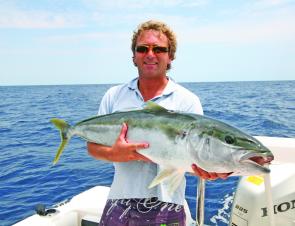It seems like we will be having a late summer this year which is not necessarily a bad thing. It simply means that we’ll have more time to pin a few jacks in the Tweed – something I am certainly looking forward to!
The jack season so far has been pretty good for those willing to put in the hours. Both live baiting and lure fishing have produced the goods. The only drawback to lure fishing is the odd loss of a favourite jack lure, but this usually just fires us up for a return trip to catch the culprit.
When chasing jacks in the Tweed the most important thing to consider is the time to be on the water. These fish are most active throughout low light periods. Early morning around daybreak, late evenings and the odd late night session are the times when jacks are most active. Over the last two months the days have become increasingly hot and the bait in the river has also steadily increased. I think this month will be one of the best to target a really good size jack. Remember that these fish are fairly restricted in their numbers, so try to handle them with care and release them.
Jacks are not the only fish around this month. Some rat kings as well as the odd amberjack have been taking lures around the mouth of the Tweed River. These fish have been extremely strong in the current for their size and anglers have had their work cut out trying to land them. The start of the run-in tide coinciding with daybreak or late afternoon sessions have been the peak times to get amongst these top fighting fish.
Bigeye trevally and giant trevally have also been around in good numbers as well as good sizes. They have been just as tough to land around the rocky banks of the Jack Evans Harbour and the North Wall. Drifting live herring or jigging soft plastics are excellent ways to get connected to some of these hard fighting fish. The trevs should be spread out throughout the system by March with the bigger models around the mouth area. All the bridges have a few trevs harassing the herring population under the cover of darkness. Once you arrive at a bridge just hang around for a while to see if there are any busting up. If you can’t see anything then simply head to the next bridge.
Fishos after a feed have been getting stuck into the whiting and this should continue through March. If the February rains don’t dirty the system too much, the upper reaches of the Tweed from Tumbulgum up should produce the best numbers. The usual baits will help you bring in a good feed. There have actually been good numbers of bream in the Tweed this Summer with a number of quality size fish coming out. I have caught some stonkers while casting poppers and large hard-bodied lures for the jacks, so don’t cross them off your list this month.
The upper reaches of the Tweed around Murwillumbah should still be producing the odd bass. Small hard-bodied lures, poppers and spinnerbaits cast tight up against the snags is the gun technique. Unfortunately there are a few jacks around this area and the odd lure gets donated to the red devil foundation while chasing bass.
Small blacks were still around in February but March is starting to get a little late for them. If you didn’t manage to get amongst them this season, then make sure you get out this month, as it may be your last chance until next summer. This time last year there were some massive GTs around Nine Mile and Fidos so keep a good eye out for them. Kingfish and cobia will also be around the shallower reefs and drifting livies over the NE drop on the Nine Mile could quite easily get your arms stretched.
All in all March is a top month to be on the water, so grab some gear and get amongst them!
Reads: 2490
Watch out for big marauding kings on the shallow reefs of the Tweed this month. Steve Kempe caught this one while slow trolling a live yakka for marlin.

Quality bigeye trevally have been hard to subdue around the rocky banks of the Jack Evans Boat Harbour. Expect them to be around in good numbers during March.




